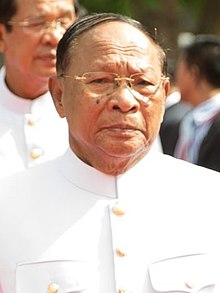Heng Samrin
Heng Samrin | |||||||||||||||||||||||||||||||
|---|---|---|---|---|---|---|---|---|---|---|---|---|---|---|---|---|---|---|---|---|---|---|---|---|---|---|---|---|---|---|---|
ហេង សំរិន | |||||||||||||||||||||||||||||||
 Samrin in 2018 | |||||||||||||||||||||||||||||||
| President of the National Assembly | |||||||||||||||||||||||||||||||
| In office 21 March 2006 – 22 August 2023 | |||||||||||||||||||||||||||||||
| Monarch | Norodom Sihamoni | ||||||||||||||||||||||||||||||
| Vice President | Cheam Yeab Khuon Sodary Nguon Nhel Say Chhum Kem Sokha You Hockry | ||||||||||||||||||||||||||||||
| Preceded by | Norodom Ranariddh | ||||||||||||||||||||||||||||||
| Succeeded by | Khuon Sodary | ||||||||||||||||||||||||||||||
| |||||||||||||||||||||||||||||||
| Personal details | |||||||||||||||||||||||||||||||
| Born | 25 May 1934 Ponhea Kraek District, Kampong Cham Province, Cambodia, French Indochina (now in Tboung Khmum Province) | ||||||||||||||||||||||||||||||
| Political party | Cambodian People's Party | ||||||||||||||||||||||||||||||
| Spouse | Sao Ty | ||||||||||||||||||||||||||||||
| Children | 4 | ||||||||||||||||||||||||||||||
| Military service | |||||||||||||||||||||||||||||||
| Allegiance | |||||||||||||||||||||||||||||||
| Branch/service | Royal Cambodian Army | ||||||||||||||||||||||||||||||
| Rank | Five-Star General[1][2] | ||||||||||||||||||||||||||||||
Heng Samrin (Khmer: ហេង សំរិន; born 25 May 1934) is a Cambodian politician who served as the President of the National Assembly of Cambodia (2006–2023). Between 1979 and 1992, he was the de facto leader of the Hanoi-backed People's Republic of Kampuchea (1979–1989) and State of Cambodia (1989–1992) and General Secretary of the Kampuchean People's Revolutionary Party (1981–1991).
He has been a member of Parliament since 14 June 1993. He is the oldest member of parliament, and the longest-serving president of the National Assembly in history. His honorary title is "Samdech Akka Moha Ponhea Chakrei Heng Samrin" (Khmer: សម្តេចអគ្គមហាពញាចក្រី ហេង សំរិន).
Life and career[edit]
Heng Samrin was born in Kampong Cham Province, Cambodia, in 1934. He joined the Khmer Rouge communist movement led by Pol Pot, and became a political commissar and army division commander when the Khmer Rouge, backed by China, took over the government in 1975. In 1978, after a series of violent purges within the Khmer Rouge leadership in which many prominent cadre members whom Pol Pot felt might be rivals were executed, he fled to Vietnam.[3]
In Vietnam, he was one of the founding members of the Kampuchean United Front for National Salvation (FUNSK). Later that year, Heng returned to Cambodia and organized a resistance movement with the backing and support of Vietnam and the Soviet Union.
After a Vietnamese invasion of Cambodia overthrew the regime of Khmer Rouge in 1979, Vietnamese occupation authorities established the People's Republic of Kampuchea, installing Heng and other pro-Vietnamese Communist politicians as leaders of the new government.[4] He became chairman of the People's Revolutionary Council of the PRK in 1979. In 1981, he became chairman of the Council of State and secretary-general of the People's Revolutionary Party. Though at first he was the effective leader of the government, he lost much of his political power when Hun Sen became Prime Minister of Cambodia in 1985.
As Vietnamese influence declined, Samrin gradually lost his posts, including the post of secretary-general in 1991 and chairman of the council of state in 1992. When King Norodom Sihanouk was restored in 1993, Samrin was given the honorary title of Sâmdech, senior advisor of the King, and was made honorary chairman of Hun Sen's Cambodian People's Party. He was vice chairman of the National Assembly of Cambodia (1998–2006). Since 2006, he has acted as Chairman of the Solidarity Front for Development of the Cambodian Motherland.
The Cambodian People's Party recently released a book about Samrin called A Man of the People,[5] dedicated to him as a hero.[6] According to that book, among supporters of the ruling CPP Heng Samrin is a "much loved and respected figure", even though his recent duties are often largely ceremonial.[7] His full title is Samdach Akeak Moha Ponhea Chakrei Heng Samrin, Protean Radhsaphea ney Preah Reacheanachak Kampuchea (Khmer: សម្តេចអគ្គមហាពញាចក្រី ហេង សំរិន ប្រធានរដ្ឋសភា នៃព្រះរាជាណាចក្រកម្ពុជា).
See also[edit]
References[edit]
- ^ "ROYAL LETTER: Sihanouk praises five star leaders".
- ^ "Welcome to Cambodian People's Party- CPP News and Information World Wide: His Majesty Promotes Cambodian Leaders to Five-Star General". 27 December 2009.
- ^ Jackson, Karl D. (2014). Cambodia, 1975-1978: Rendezvous with Death. Princeton University Press. p. 206. ISBN 9781400851706. Retrieved 16 November 2015.
- ^ Heller, H (2007). "Cambodia: Modern History". In Marshall Cavendish (ed.). World and Its peoples: Eastern and Southern Asia. Vol. 6. p. 765.
- ^ Heng Samrin, A Man of the People.
- ^ Hunt, Luke. "Heng Samrin, Man of the People". Retrieved 1 June 2012.
- ^ Hunt, Luke. "Heng Samrin, Man of the People". The Diplomate. Retrieved 1 June 2012.
External links[edit]
- Presidents of the National Assembly (Cambodia)
- 1934 births
- 20th-century Cambodian politicians
- 21st-century Cambodian politicians
- Living people
- People's Republic of Kampuchea
- Kampuchean United Front for National Salvation politicians
- Communist Party of Kampuchea politicians
- Cambodian People's Party politicians
- Heads of state of Cambodia
- Cambodian communists
- Cambodian revolutionaries
- Cambodian Theravada Buddhists
- People from Kampong Cham province
- People from Tboung Khmum province



